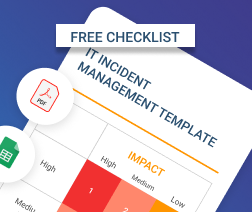IT service management, or ITSM for short, is a strategic approach to optimizing and improving IT service company strategy, goals, objectives, and processes to maximize the quality of the service provided to the customer. This approach is popular among managed service providers who target bigger clients with more advanced IT needs and demands, or those whose aim is to build a flawless and streamlined service.
In this article, we will overview ITSM and its structure, define the benefits for MSPs from using it, and discuss the most popular approaches to providing advanced IT service management.
How Can MSPs Benefit from ITSM?
Before you read any further, it should be said that ITSM serves as a basis for the creation of more-focused and detailed frameworks. This means that ITSM as such cannot be directly implemented in an organization.
How can an MSP benefit from ITSM? You should understand its principles and choose the most appropriate framework for your organization and vision. The most popular ITSM framework in the world is called ITIL. It's so popular, in fact, that oftentimes it's mistakenly called ITSM.
Further reading ITIL for MSPs Explained
ITSM Basics
ITSM emerged when it became clear that no company could survive without a proper IT infrastructure. Its aim was to standardize the approach to, and the language of, IT service provision to allow companies not focused on IT to enjoy the same level of service regardless of the specific service provider. Thus, ITSM is a vision of how an IT service company should be built and run, how the strategy should be defined, and how goals should be set. It is a high-level strategy and does not provide an overview of the exact processes, KPIs, reports, or team roles.
Redefining MSP Strategy
First of all, while focusing on ITSM, you need to perform a strategic review of your MSP:
- Vision. The broad ideology of your company. ”Become the best,” ”Provide services flawlessly,” ”Our customer is a happy customer,” are all examples of a vision.
- Mission. Several ways of achieving the vision.
- Objectives. The exact steps for achieving the mission.
After you have formulated the objectives, you should create a policy that includes planned actions, budgets, and review checkpoints for the whole company. These policies can further be spread across your teams to create short-term, team-based plans. All objectives, plans, and policies should be SMART: specific, measurable, appropriate, realistic, and time-bound.
Unless your objectives are measurable, you cannot effectively track the accomplishment of your mission and cannot set the KPIs for your teams.

![]()
ITSM Key Areas
From the process point of view, ITSM is broken down into four key areas:
- Quality management. How the customer defines quality and how to achieve the same level of quality while providing the services.
- Process management. How to create the needed number of processes; how processes relate to each other.
- Planning. Budgeting, change management.
- Human resources management. Workload optimization, selection of personnel, motivation, training.
As an MSP, you should constantly focus and improve these areas, review them for any pain points, and strive towards maximizing efficiency and the highest quality for your customers.
Further reading 10 Tips to Improve Your Customer Service
ITSM Processes
ITSM stresses the importance of processes for any IT service organization. A process can be defined as the actions needed to achieve the results. A process can also be defined by answering these four questions:
- What should be done?
- What is the expected result?
- How can we measure success?
- How do the results of one process affect others?
The processes can best be visualized in the form of diagrams. All provided services should be broken down into processes and structured to serve the operational and strategic goals of the MSP and its clients.
How MSPs Can Learn About ITSM
The main source of knowledge about ITSM is the itSMF – IT service management forum. It is a non-commercial organization that hosts a number of international events to popularize the ITSM approach and to share the experience of professionals from IT service management spheres. However, as we've already mentioned, ITSM cannot be seen as an independent discipline and should be studied alongside one of the frameworks based on it. Thus, any written guide on any framework based on ITSM will adhere to its principles.
Is There any Certification?
No, you cannot be ITSM-certified, since this is a general approach. However, there are several popular frameworks that are based on ITSM. These frameworks are more-detailed, process-based documents, and standards that are developed by public or private companies. The most popular ITSM framework among the managed IT providers and in the corporate world is ITIL – IT Infrastructure Library.
Conclusion
Excellence in providing services can become the key factor in the success of your managed IT business. Define your core values and strategy, focus and educate your team, and you will see how, gradually, your customers will become more satisfied with your services, and your MRR will eventually grow






